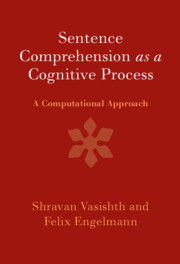Book contents
- Frontmatter
- Contents
- List of Figures
- List of Tables
- Foreword by Richard L. Lewis
- Preface
- Acknowledgements
- 1 Introduction
- 2 Dependencies in Sentence Comprehension
- 3 The Core ACT-R-Based Model of Retrieval Processes
- 4 An Extension of the Core Model: Modelling Prominence and Multi-associative Cues
- 5 An Extension of the Core Model: Modelling the Interaction of Eye-Movement Control and Parsing
- 6 Reanalysis and Underspecification in Sentence Comprehension: Modelling Eye Movements
- 7 Competing Accounts of Interference in Sentence Processing
- 8 Modelling Sentence Comprehension Deficits in Aphasia
- 9 Future Directions
- Bibliography
- Index
8 - Modelling Sentence Comprehension Deficits in Aphasia
Published online by Cambridge University Press: 29 October 2021
- Frontmatter
- Contents
- List of Figures
- List of Tables
- Foreword by Richard L. Lewis
- Preface
- Acknowledgements
- 1 Introduction
- 2 Dependencies in Sentence Comprehension
- 3 The Core ACT-R-Based Model of Retrieval Processes
- 4 An Extension of the Core Model: Modelling Prominence and Multi-associative Cues
- 5 An Extension of the Core Model: Modelling the Interaction of Eye-Movement Control and Parsing
- 6 Reanalysis and Underspecification in Sentence Comprehension: Modelling Eye Movements
- 7 Competing Accounts of Interference in Sentence Processing
- 8 Modelling Sentence Comprehension Deficits in Aphasia
- 9 Future Directions
- Bibliography
- Index
Summary
This chapter investigates whether sentence comprehension difficulty in aphasia can be explained in terms of retrieval processes. By modelling individuals with aphasia (IWAs) separately, we show that different IWAs show impairments along different dimensions: slowed processing, intermittent deficiency, and resource reduction. The parameters in the cue-based retrieval model have a theoretical interpretation that allows these three theories to be implemented within the architecture. In a further investigation, we compare the relative predictive accuracy of the cue-based model with that of the direct-access model. The benchmark data here are from Caplan et al. (2015); k-fold cross-validation is used as in the preceding chapter. The cue-based retrieval model is shown to have a better predictive performance.
Information
- Type
- Chapter
- Information
- Sentence Comprehension as a Cognitive ProcessA Computational Approach, pp. 178 - 199Publisher: Cambridge University PressPrint publication year: 2021
